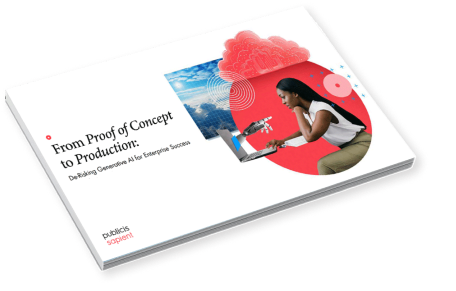What issue can we solve for you?
Type in your prompt above or try one of these suggestions
Suggested Prompt



Insights
The Top 5 Generative AI Trends in 2025
The Top 5 Generative AI Trends in 2025
How to revolutionize business with AI agents, content supply chains and workforce transformation.
Generative AI is quietly reshaping the workplace, with 28 percent of U.S. workers already using it, according to the National Bureau of Economic Research (NBER). For 11 percent, it's a daily tool used alongside email and meetings, while 24 percent use it weekly. Globally, it's accessed 3 billion times a month by millions.
In business, management and tech roles, usage rates soar above 40 percent. Companies are taking note, with over a third of C-suite executives reporting that they’ve set aside dedicated budgets for artificial intelligence (AI) projects in a recent Publicis Sapient global survey. Additionally, AI software spending overall is expected to reach nearly $300 billion by 2027.
As generative AI continues to reshape the landscape of software development, executives must embrace a holistic approach that integrates AI across the entire product lifecycle to potentially unlock productivity gains of up to 40 percent.
The successful collaboration between humans and AI requires a workforce equipped with strong problem-solving skills and a commitment to rigorous oversight, ensuring that AI outputs are not just accepted but critically evaluated. Furthermore, leveraging proprietary data to train custom generative AI models will provide organizations with a significant competitive edge, distinguishing them from competitors relying on generic public models.
As we move toward 2025, these five trends and predictions will define generative AI’s future:
- Agentic AI autonomy
- Smarter content supply chains
- Worker upskilling
- Rising cloud costs
- Data security and ethics
These forces will shape AI’s role not just as a tool but as a cornerstone of enterprise strategy. The future of work is being rewritten—by the algorithms that power it.


Guide to Next 2025
How will generative AI impact your industry in 2025?
Find out in the Guide to Next 2025 report.
“Our opportunity is not just about reducing costs or replacing human effort. Instead, it's about unlocking unparalleled opportunities for growth and innovation.”
Simon James , Managing Director, Data & AI at Publicis Sapient

The rise of AI agents: from task assistants to workflow orchestrators
AI agents, autonomous tools with specialist skill sets, are set to move far beyond their current roles as task assistants, becoming workflow orchestrators capable of autonomously managing complex business processes. This shift will fundamentally change how enterprises operate, driving unprecedented levels of efficiency and decision-making speed.
Microsoft believes that agents will become the new apps for an AI-powered world, where every organization will have a collection of agents, ranging from basic prompt-and-response to fully autonomous. Microsoft's introduction of "Copilots" through Copilot Studio, rolling out in November 2024, illustrates the coming transformation. Microsoft’s Dynamics 365 suite will feature 10 autonomous agents dedicated to streamlining critical operations.
These AI agents will analyze data across multiple systems of record and automate routine workflows, drastically enhancing operational efficiency, especially within the software development lifecycle (SDLC). One global study highlights that by mid-2025, more than 65 percent of executives expect to have integrated AI agents into their business functions. This integration could lead to a 40 percent increase in productivity and a reduction in time from idea to live, according to Publicis Sapient analysis.
For example, SAP included agent capabilities in its generative AI assistant, Joule, in early October 2024. These features are designed to address financial dispute resolution, bill payments, and ledger updates.
This capability marks a significant leap for businesses aiming to streamline operations and boost productivity. With 82 percent of organizations planning to integrate autonomous AI agents in the next one to three years, and major players like OpenAI and Salesforce already announcing them, the evolution of AI from assistant to orchestrator is no longer theoretical—it’s imminent.

Generative AI revolutionizing the content supply chain: personalized, targeted and efficient
In 2025, the real challenge for generative AI won’t just be speeding up the content supply chain—it will be breaking out of the “cheaper, faster” trap to deliver higher-quality content that truly enhances the digital experience. From marketing campaigns tailored to specific geographic regions to content adapted in real time based on audience preferences, AI will enable unprecedented levels of personalization and efficiency.
According to a Publicis Sapient global C-suite survey, only 11 percent of companies are building custom generative AI solutions for use cases like the content supply chain. In contrast, the majority of organizations are still using free, publicly available tools, which aren’t able to scale high-quality, branded and personalized content without errors.
While this allows marketers and sales teams to create content faster, in many cases, the quality isn’t better—and the trade-off between speed and cost isn’t worth it.
“We’ve all heard of the phrase, ‘cheaper, faster, better—pick two.’ AI-generated content is stuck in the ‘cheaper and faster’ box. Our digital services are getting worse and worse because they are getting cheaper. But a better future is not just a more efficient future.”
Simon James , Managing Director, Data & AI at Publicis Sapient
As more companies invest in custom generative AI solutions, higher-quality content becomes a possibility. Imagine a global retail brand using AI to generate marketing materials customized for every market it operates in, while simultaneously receiving real-time feedback on performance. This kind of integration will empower brands to create content faster, with deeper insight into what resonates with customers.
Already, Mondelēz International, in partnership with Publicis Groupe, is scaling AI-driven marketing campaigns to personalize content based on regional preferences, optimizing not only content creation but also the distribution process.
Media companies are also using generative AI to personalize content discovery on direct-to-consumer sports platforms, making it easier for fans to find content relevant to their interests.
The use of AI in content supply chains will be driven by its ability to deliver relevant, engaging material at scale. However, as AI becomes more prominent in content creation, the risk of sameness and market saturation grows. The temptation to prioritize cost over quality is high, given the ease of generative AI. To avoid this, executives should focus on human-AI collaboration—using creative prompting and strategic oversight to ensure unique, high-quality content that stands out while still improving speed and efficiency.

The urgent need for mass upskilling: preparing the workforce for the AI-driven future
As generative AI reshapes industries, the greatest challenge won’t be mastering the technology itself but rather implementing workforce change management to avoid a growing digital divide.
By 2027, 80 percent of software engineers will require significant upskilling to navigate the evolving landscape of AI-driven development. This trend highlights the critical need for companies to invest in workforce development, preparing employees to guide AI systems, not just code them. But the upskilling goes beyond engineers; new roles, such as the "AI engineer," will emerge, with professionals focusing on managing AI agents and maintaining ethical guardrails within agile AI-augmented workflows.
“The most underestimated challenge of AI is change management. There is a great risk of a digital divide with a two-tier workforce—those that can utilize AI tools and those that cannot.”
Simon James , Managing Director, Data & AI at Publicis Sapient
The concept of "AI-first" thinking will become essential. This new mindset will involve shifting focus from traditional software development to managing AI agents, ensuring they perform tasks ethically and efficiently. Upskilling will not be limited to technical knowledge—it will require a reorientation of roles, as professionals learn to co-create with AI and direct these systems within the appropriate contexts.
Sixty percent of managers anticipate a shift in entry-level roles from content creation to reviewing AI-generated outputs over the next three years. This suggests a need to train employees on quality control and assessment of AI-generated content. Executives identify cybersecurity, AI and data as top priorities for training investments.
For C-suite executives, prioritizing upskilling programs will be key to remaining competitive in the AI era. For example, S&P Global has already launched an upskilling sprint for its 35,000 employees to equip them with the skills to effectively utilize generative AI. The program involves certification programs and hybrid learning approaches.
JPMorgan Chase has integrated prompt engineering training into the onboarding program for its asset and wealth management department. This training focuses on teaching employees how to effectively interact with AI systems to achieve desired outcomes.
Technology vendors like Salesforce, AWS, Microsoft and Google are also expanding their training offerings to meet the growing demand for generative AI skills. Salesforce has committed $50 million to waive fees for AI courses.
In 2025, these trainings will morph from basic awareness and use of publicly available tools to full organizational change management. This shift will involve designing new role descriptions focused on the creation and maintenance of custom, enterprise generative AI solutions.

The escalating cloud cost conundrum: balancing AI benefits with financial prudence
With enterprise cloud expenses rising sharply, organizations are rethinking how to balance innovation with financial sustainability—including exploring alternatives like building and hosting AI models in their own data centers. According to a report by Tangoe, enterprise cloud costs rose by an average of 30 percent in 2024, a significant portion of which is attributed to the expansion of AI applications.
The flexibility and scalability of cloud platforms make them indispensable for AI, but the associated costs can quickly become unmanageable. Chris Ortbals, Tangoe’s chief product officer, warned that these hidden expenses are the "silent killer" of generative AI, and businesses must seek new ways to optimize their cloud spending.
For executives, at minimum, this means developing robust cost management strategies to ensure that AI investments deliver a clear return. Cloud cost optimization, careful monitoring of resource use and negotiations with cloud service providers will be essential components of a balanced AI strategy.
Another option for mitigating these costs is for organizations to build and host their generative AI models in their own data centers rather than relying solely on the cloud. This strategy, already being adopted by industry leaders like Inflection AI, allows businesses to maintain greater control over their infrastructure while potentially reducing long-term expenses.
According to analysts from HFS Research, companies that have not fully transitioned to the cloud are in a prime position to leverage this hybrid approach. By maintaining a blend of on-premises and cloud-based solutions, enterprises can strike a balance between flexibility and cost-efficiency as they scale their AI capabilities.

Heightened data privacy and ethical concerns: navigating the complex terrain of responsible AI
As 2025 approaches, evolving data regulations will require organizations to stay ahead by addressing growing concerns around generative AI data privacy and ethics, with new guidelines emerging for both consumers and workers. According to Publicis Sapient’s 2024 Generative AI Innovation report, 53 percent of C-suite leaders say issues like data quality, access, silos and privacy significantly impact their organization's growth. Generative AI systems rely on vast data, posing risks related to privacy violations, intellectual property disputes and biased information. The issue of AI "hallucinations," where systems generate inaccurate data, adds further complexity.
Already, the EU AI Act mandates risk management for high-risk AI applications, while the Department of Labor (DOL) emphasizes responsible AI use to protect employee rights. The Securities and Exchange Commission (SEC) is also pushing for transparency, warning companies against making unsubstantiated AI claims.
Simon James, managing director of data & AI at Publicis Sapient, notes that businesses must balance risk and innovation, as "a zero-risk policy is a zero-innovation policy." To manage these risks, Publicis Sapient has developed an ethical framework, including guidelines to avoid personal data in training, implement secure sandboxes and follow robust data governance practices.
Publicis Sapient's best practices focus on minimizing privacy risks by securing user consent, using anonymization protocols and conducting security reviews, vulnerability assessments and testing for model drift. Additionally, following a zero-trust approach, encrypting data and ensuring human oversight during key decision points are crucial steps to maintain AI accountability and compliance.

Don't miss the most common generative AI risks.
This guide reveals the top five risk mitigation strategies for enterprise generative AI implementation.
Beyond 2025: the future of generative AI
As generative AI continues to evolve, it's crucial to recognize that many of today's best practices and tools may become obsolete in the near future. We are still in the early stages of understanding how to fully harness generative AI's potential while managing its risks. In such a rapidly changing landscape, businesses should prioritize long-term, stable principles—like data privacy, ethical AI use and robust security—since these fundamentals are less likely to shift even as technology advances.
Navigating the tumultuous period ahead will require a flexible approach, but focusing on these core values will help organizations adapt while maintaining trust and integrity.
Related Articles
-
![]()
Insight
The Generative AI Risk Management Playbook
Most generative AI projects stall before launch. This guide reveals how to overcome common challenges and get your prototypes to production faster.
-
![]()
Case Study
Marriott Transforms Vacation Home Search with Generative AI
Travelers describe their dream getaway, and the flexible search tool finds matching destinations and rentals.
-
![]()
Case Study
Dot-Com Déjà Vu?
The AI boom recalls the dot-com bubble of the 1990s and 2000s. What lessons from the past can businesses learn to help them succeed today and tomorrow?







